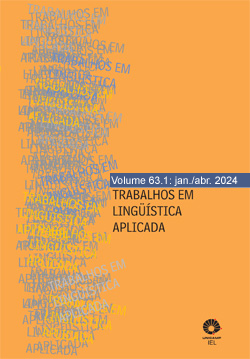Abstract
The presence of literature in additional language teaching incorporates the premise that there is a consensus on its importance in the classroom. However, hesitation regarding the manner of its utilization still permeates the beliefs of teachers and researchers, notably in instructional materials and lesson planning. Based on concepts of the construction of intercultural meaning in literary reading in Portuguese as an additional language classes, it is argued that literary texts are fundamental elements in the development of the cognitive process, balancing their aesthetic and dialogical dimensions with students' worldviews. In this perspective, as the relationship between mediator, literary text, and reader is strengthened, strategic models reveal themselves in course planning. The aim of this study is to investigate such models, with the purpose of examining procedures for teaching literary reading to foreign language learners, based on their experiences of reading as an educational and social practice. Through the analysis of these procedures in additional language classes, the aim is to demonstrate and enhance the functioning of mediation mechanisms beyond the limits of textbooks, while still being an integral part of teaching activities and materials. As a result, it becomes possible to answer what is the role of reading literary texts in the process of assimilation of the Portuguese language and how the teacher can contribute to his didactic practice of mediation by allowing himself to approach social practice and build meanings, linking empirical knowledge and intercultural knowledge.
References
ABREU, Márcia (2006). Cultura letrada: literatura e leitura. São Paulo: Editora UNESP.
BAKHTIN, Mikhail (2003). Estética da criação verbal. São Paulo: Martins Fontes.
BRASIL (2020). Ministério das Relações Exteriores. Proposta curricular para cursos de literatura brasileira nas unidades da rede de ensino do Itamaraty no exterior – Brasília : FUNAG, 2020. 60 p. – (Propostas curriculares para ensino de português no exterior)
CANDIDO, Antonio (2011). O direito à literatura. In: Vários escritos. 5ª ed. São Paulo/Rio de Janeiro: Duas Cidades/Ouro sobre Azul, p. 169-179.
COSSON, Rildo J. (2015) A prática da leitura literária na escola: mediação ou ensino?. Nuances: estudos sobre Educação, v. 26, n. 3, p. 161-173.
FREIRE, Paulo (1996). Pedagogia da autonomia. Rio de Janeiro: Paz e Terra; Anca/MST, 2002.
FREIRE, Paulo (2006). A importância do ato de ler. 47. ed. São Paulo: Cortez.
JOUVE, Vincent et al (2010). Entrevista com Vincent Jouve, autor de A leitura. Tradução de Brigitte Hervot. Leitura em Revista. Cátedra UNESCO de Leitura PUC-Rio, n. 1.
KRAMSCH, Claire (1993). Culture in foreign language teaching. In: Iranian Journal of Language Teaching Research. n. 1, p. 57-78, 1993. Disponível em: <http://www.urmia.ac.ir/ijltr>. Acesso em 30 abr. 2023.
KRAMSCH, Claire (2006). From communicative competence to symbolic competence. In: The Modern Language Journal, Wiley, v. 90, n. 2, p. 249-252, Summer, 2006. Disponível em: <http://www.jstor.org/stable/3876875>. Acesso em: 10 jun. 2023.
KRASHEN, Stephen (1982). Principles and Practice in Second Language Acquisition. Pergamon Press. Disponível em: <http://www.sdkrashen.com/Principles_and_Practice/Principles_and_Practice.pdf> Acesso em 30 abr. 2023.
KUMARAVADIVELU, Bala (2001). Toward a postmethod pedagogy. TESOL quarterly, v. 35, n. 4, p. 537-560, 2001.
LAJOLO, Marisa (2007). Do mundo da leitura para a leitura do mundo. 6. ed., 12. impressão, São Paulo: Ática.
LAJOLO, Marisa; ZILBERMAN, Regina (1996). Livro didático, matéria da literatura. In: A formação da leitura no Brasil. São Paulo: Ática, p. 120-1
LEFFA, Vilson J. (2003). Como produzir materiais para o ensino de línguas. In: Produção de materiais de ensino: teoria e prática. Pelotas: EDUCAT, p. 13-38.
LEFFA, Vilson (2012). Ensino de línguas: passado, presente e futuro. Revista de estudos da linguagem, v. 20, n. 2, p. 389-411.
PETIT, Michèle (2009). A arte de ler ou como resistir à adversidade. São Paulo: Ed. 34.
PETIT, Michèle (2019). Ler o mundo: experiências de transmissão cultural nos dias de hoje. São Paulo: Editora 34.
REYES, Yolanda. Mediadores de leitura. In: FRADE, Isabel Cristina Alves da Silva; VAL, Maria da Graça Ferreira da Costa; BREGUNCI, Maria das Graças de Castro (orgs.). Glossário Ceale: termos de alfabetização, leitura e escrita para alfabetizadores. Belo Horizonte: UFMG/Ceale, 2014.
TAKAHASHI, Neide Tomiko (2013) Leitura literária no ensino-aprendizagem do português para universitários estrangeiros. Linha D’Água, São Paulo, n. 26 (1), p. 119-40.
TAKAHASHI, Neide Tomiko (2014). Textos literários no ensino de português para falantes de outras línguas em contexto universitário. Estudos Linguísticos (São Paulo. 1978), 43(2), 868-881.
TAKAHASHI, Neide Tomiko (2015). Leitura literária em português-língua estrangeira (PLE): representações, compreensão e produção textual. Tese de Doutorado. Universidade de São Paulo.

This work is licensed under a Creative Commons Attribution 4.0 International License.
Copyright (c) 2023 Neide Tomiko Takahashi


